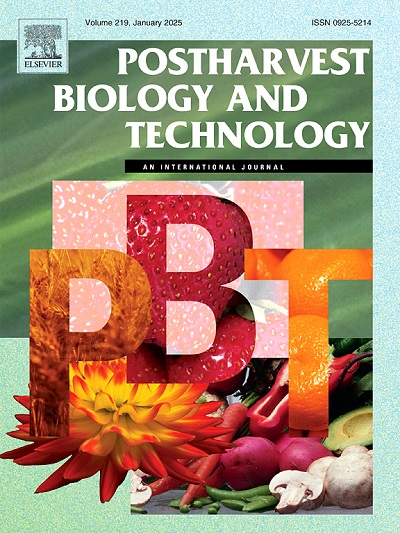大肠杆菌O157:H7在长叶莴苣收获至贮藏期间的转录组反应
IF 6.8
1区 农林科学
Q1 AGRONOMY
引用次数: 0
摘要
商业收获的生菜通常经历短途或长途运输,从种植区到目的地市场附近的设施进行新鲜切割加工。收获和加工之间的时间间隔因加工设施的位置而异。为了确定预处理间隔时间(1天和8天)如何影响食品安全风险,我们研究了收获前和收获后的预处理条件如何影响生菜相关大肠杆菌O157:H7的基因表达模式,使用参考菌株EDL933和最近反复出现的生菜爆发菌株2705C。在大肠杆菌O157:H7中检测到转录组的变化,这些变化在收获前对生菜叶球有响应,随后在收获后的1天或8天的储存条件下(4°C, 99 % RH,没有或间隔降低大气压)。收获前,与压力相关的基因上调在两种菌株中都很常见;包括氧化、渗透和酸胁迫、饥饿反应、冷休克和抗菌素胁迫。这两种菌株似乎都形成了生物膜,但两种菌株之间的差异基因表达模式表明它们采用了不同的策略来适应生菜层球并切换到生物膜状态。EDL933的初始反应主要包括运动性、趋化性和群体感应基因的上调,而2705C则更明显地上调了不可逆附着所需的基因,并且涉及更多与氧化和抗菌应激相关的基因。两种菌株的渗透胁迫、冷休克和抗菌素胁迫基因的高表达在收获后持续或增加。另一方面,爆发菌株2705C从收获前到收获后,几个参与饥饿、氧化和酸胁迫以及附着的基因被下调,而EDL933的表达水平基本保持不变。在这两种菌株中,参与氧化和酸胁迫的yhcN、参与生物膜形成的bhsA以及参与抗菌化合物外排的mdtG和marB的表达在收获后的储存中进一步增加。除了EDL933中的固定相基因mgtS外,大肠杆菌O157:H7中与生菜相关的几个基因在预处理延迟8 d的情况下均下调,而预处理延迟1 d的时间较长。虽然一些基因被下调,但没有检测到针对长时间储存或大气压力波动(模拟前向预处理延迟)的转录组反应。总的来说,这些结果表明,大肠杆菌O157:H7对收获前生菜表面恶劣、营养匮乏的适应涉及到压力适应,这种适应以菌株依赖的方式为收获后的储存条件做好了准备。在收获前叶圈诱导并在收获后生菜中持续的一组基因可以使该病原体预先适应收获后处理的条件,如消毒剂暴露。研究结果揭示了大肠杆菌O157:H7与生菜收获前后的遗传机制差异,这可能转化为不同的食品安全风险。本文章由计算机程序翻译,如有差异,请以英文原文为准。
Transcriptomic response of Escherichia coli O157:H7 on Romaine lettuce from harvest to storage during the pre-processing interval
Commercially harvested lettuce generally undergoes short- or long-haul transportation from the growing region to facilities near the destination markets for fresh-cut processing. The interval of time between harvest and processing varies by location of the processing facility. To determine how duration of the pre-processing interval (1 versus 8 d) may affect food safety risk, we investigated how pre-harvest and post-harvest, pre-processing conditions affected the gene expression patterns of lettuce-associated Escherichia coli O157:H7, using the reference strain EDL933 and a recent, recurring lettuce outbreak strain 2705C. Transcriptomic shifts were detected in E. coli O157:H7 responding to the lettuce phyllosphere pre-harvest, and subsequently under one or eight days of storage conditions post-harvest (4 °C, 99 % RH, without or with an interval of reduced atmospheric pressure). Pre-harvest, up-regulation of genes linked to stress was common to both strains; including oxidative, osmotic and acid stress, the starvation response, cold shock and antimicrobial stress. Both strains appeared to form biofilms, but differential gene expression patterns between the two strains suggested that they utilized distinct strategies to adapt to the lettuce phyllosphere and switch to a biofilm state. While initial EDL933 responses predominantly encompassed up-regulation of motility, chemotaxis and quorum sensing genes, 2705C more markedly up-regulated genes needed for irreversible attachment, and involved more genes related to oxidative and antimicrobial stress. The elevated expression of osmotic stress, cold shock and antimicrobial stress genes in both strains were sustained or increased throughout the post-harvest interval. On the other hand, down-regulation of several genes involved in starvation, oxidative and acid stress, and attachment was detected in the outbreak strain 2705C from pre- to post-harvest conditions, while expression levels in EDL933 remained mostly unchanged. In both strains, the expression of yhcN, involved in oxidative and acid stress, bhsA, involved in biofilm formation, and mdtG and marB, involved in efflux of antimicrobial compounds, were further augmented in post-harvest storage. Except for the stationary phase gene mgtS in EDL933, the few genes that were differentially regulated in E. coli O157:H7 associated with lettuce subjected to a prolonged 8-d pre-processing delay, compared to a short 1-d interval, were down-regulated. While some genes were downregulated, no transcriptomic response specific to prolonged storage or fluctuations in atmospheric pressure (simulating forward pre-processing delays) was detected. Overall, these results suggest that E. coli O157:H7 adaptation to the harsh, nutrient-depleted pre-harvest lettuce surface involved stress adaptations that primed the bacteria for post-harvest conditions in storage, in a strain-dependent manner. The suite of genes induced in the pre-harvest phyllosphere and sustained in post-harvest lettuce could pre-adapt this pathogen to conditions during post-harvest handling such as sanitizer exposure. Findings provide insights on strain differences in the genetic mechanisms adopted by E. coli O157:H7 associating with lettuce pre- and post-harvest, which could translate to variable food safety risk.
求助全文
通过发布文献求助,成功后即可免费获取论文全文。
去求助
来源期刊

Postharvest Biology and Technology
农林科学-农艺学
CiteScore
12.00
自引率
11.40%
发文量
309
审稿时长
38 days
期刊介绍:
The journal is devoted exclusively to the publication of original papers, review articles and frontiers articles on biological and technological postharvest research. This includes the areas of postharvest storage, treatments and underpinning mechanisms, quality evaluation, packaging, handling and distribution of fresh horticultural crops including fruit, vegetables, flowers and nuts, but excluding grains, seeds and forages.
Papers reporting novel insights from fundamental and interdisciplinary research will be particularly encouraged. These disciplines include systems biology, bioinformatics, entomology, plant physiology, plant pathology, (bio)chemistry, engineering, modelling, and technologies for nondestructive testing.
Manuscripts on fresh food crops that will be further processed after postharvest storage, or on food processes beyond refrigeration, packaging and minimal processing will not be considered.
 求助内容:
求助内容: 应助结果提醒方式:
应助结果提醒方式:


